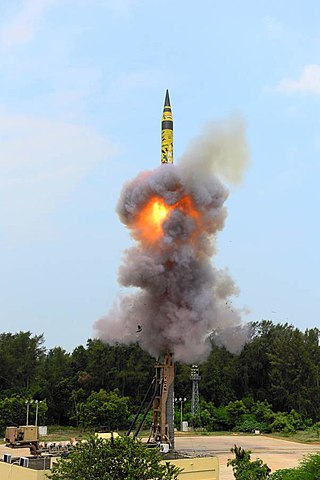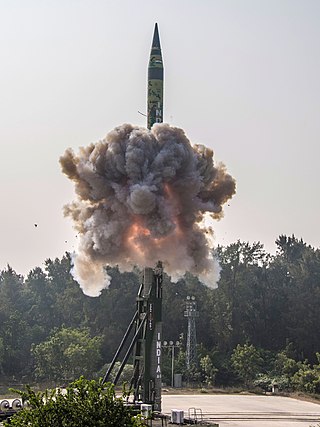
The Agni-III is an Indian intermediate-range ballistic missile inducted into service in 2011 as the successor of the Agni-II. It has a range of 3,500 to 5,000 kilometres and can reach targets deep inside neighbouring countries including PAKISTAN & China.

India possesses nuclear weapons and previously developed chemical weapons. Although India has not released any official statements about the size of its nuclear arsenal, recent estimates suggest that India has 164 nuclear weapons and has produced enough weapons-grade plutonium for up to 200 nuclear weapons. In 1999, India was estimated to have 800 kilograms (1,800 lb) of separated reactor-grade plutonium, with a total amount of 8,300 kilograms (18,300 lb) of civilian plutonium, enough for approximately 1,000 nuclear weapons. India has conducted nuclear weapons tests in a pair of series namely Pokhran I and Pokhran II.
The Strategic Forces Command (SFC), sometimes called Strategic Nuclear Command, forms part of India's Nuclear Command Authority (NCA). It is responsible for the management and administration of the country's tactical and strategic nuclear weapons stockpile. It was created on 4 January 2003 by the Vajpayee Government. Air Marshal Teja Mohan Asthana became its first commander-in-chief.

A nuclear triad is a three-pronged military force structure of land-based intercontinental ballistic missiles (ICBMs), submarine-launched ballistic missiles (SLBMs), and strategic bombers with nuclear bombs and missiles. Countries build nuclear triads to eliminate an enemy's ability to destroy a nation's nuclear forces in a first-strike attack, which preserves their own ability to launch a second strike and therefore increases their nuclear deterrence.

Sagarika, also known by the code names K-15 or B-05, is an Indian submarine-launched ballistic missile (SLBM) with a range of 750 kilometres (466 mi) that was designed for retaliatory nuclear strikes. It belongs to the K Missile family and forms a part of India's nuclear triad.

The Arihant-class is a class of Indian nuclear-powered ballistic missile submarines being built for the Indian Navy. They were developed under the ₹900 billion (US$11 billion) Advanced Technology Vessel (ATV) project to design and build nuclear-powered submarines. These vessels are classified as 'strategic strike nuclear submarines' by India.
The Department of Defence Production of the Ministry of Defence is responsible for the indigenous production of equipment used by the Indian Navy and the other armed forces. It comprises the 41 Indian Ordnance Factories under control of the Ordnance Factories Board and eight Defence PSUs: HAL, BEL, BEML, BDL, MDL, GSL, GRSE and Midhani. The present weapon systems of the Indian Navy are:

The Agni missile is a family of medium to intercontinental range ballistic missiles developed by India, named after one of the five elements of nature. Agni missiles are long-range, nuclear weapons capable, surface-to-surface ballistic missiles. The first missile of the series, Agni-I was developed under the Integrated Guided Missile Development Programme (lGMDP) and tested in 1989. After its success, the Agni missile programme was separated from the GMDP upon realizing its strategic importance. It was designated as a special programme in India's defence budget and provided adequate funds for subsequent development. As of November 2019, the missiles in the Agni series are being inducted into service. The family comprises the following:

Agni-IV ("Fire") is the fourth in the Agni series of missiles which was earlier known as Agni II prime. It has been developed by India's DRDO and displayed a number of new technologies and significant improvement in missile technology. The missile is light-weight and has two stages of solid propulsion and a payload with re-entry heat shield. With 4,000 km range, it is capable of striking targets in nearly all of mainland China, if launched from northeastern part of India.

Shaurya is a canister-launched hypersonic surface-to-surface tactical missile developed by the Indian Defence Research and Development Organisation (DRDO) for use by the Indian Armed Forces. It has a range of 700 to 1,900 km and is capable of carrying a payload of 200 to 1,000 kg conventional or nuclear warhead. It provides the potential to strike at very-long-range against any adversary.

Agni-I is a short-range ballistic missile that was developed by DRDO of India in the Integrated Guided Missile Development Program. It is a single-stage missile that was developed after the Kargil War to fill the gap between the 250 km (160-mile) range of the Prithvi-II missile and the 2,500 km (1,600-mile) range of the Agni-II. It was first launched from a road mobile launcher at Integrated Test Range (ITR), Wheeler Island, on 25 January 2002. Less than 75 launchers are deployed.

Agni-V is a land based nuclear MIRV-capable Intercontinental Ballistic Missile (ICBM) developed by the Defence Research and Development Organisation (DRDO) of India. The missile has a range of more than 7,000 km. It is a three-stage, road-mobile, canisterised and solid-fueled ballistic missile.

INS Arihant, designated S2 Strategic Strike Nuclear Submarine, is the lead ship of India's Arihant class of nuclear-powered ballistic missile submarines. The 6,000 tonne vessel was built under the Advanced Technology Vessel (ATV) project at the Ship Building Centre in the port city of Visakhapatnam.
Agni-VI(Sanskrit: अग्नि; IAST: Agni; lit. Fire) is an MIRV-capable intercontinental ballistic missile under development by the Defence Research and Development Organisation (DRDO) for the Strategic Forces Command (SFC) of the Indian Armed Forces.
K-4 is a nuclear capable Intermediate-range submarine-launched ballistic missile developed by the Defence Research and Development Organisation of India to arm the Arihant-class submarines. The missile has a maximum range of about 4000 km.
India has studied, produced and used various strategic and tactical missile systems since its independence. Decades long projects have realised development of all types of missile systems including ballistic, cruise, anti-ship, air-defence, air-to-air and anti-missile systems. India is one of seven countries in the world with intercontinental ballistic missiles (ICBMs) and one of four countries with anti-ballistic missile systems. Since 2016, India has been a member of Missile Technology Control Regime (MTCR).
K-5 is a submarine-launched ballistic missile under development by Defence Research and Development Organisation of India. The missile has a planned range of around 5,000-6,000 kilometres.
K-6 is an intercontinental submarine-launched ballistic missile under development by Defence Research and Development Organisation of India. The missile has a planned range of around 10,000 to 12,000 kilometres.










